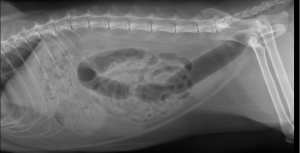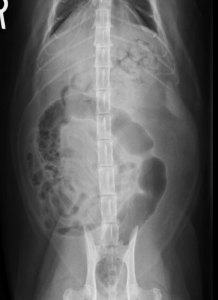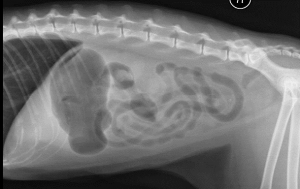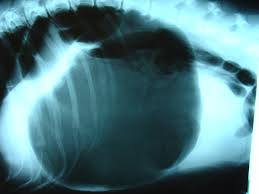55 Bloat and flatulence
Gas in the GI tract
Gas in the GI tract may be due to swallowed air (aerophagia), particularly in brachycephalic dogs (eg pugs, bull dogs) and dogs that eat very quickly. In most other animals, gas in the GI tract is mostly due to bacterial production of gas as they metabolize stuff. Gas is normally released as burps and farts (flatus). Bloat is generally due to gaseous distension.
Microbes produce more gas when they are happy and fermenting things. Microbes like
- more stuff to eat
- fermentable feedstuffs eg corn
- new stuff to eat
- more time to eat
- slowed motility
- herbivores with elongated GI tract
Bloat happens when microbes are happy and gas is trapped and can’t be released. The gas may be trapped in either free gas form (air in a balloon) or as excessive foam with frothy bloat.
Simple stomached animals (dogs, cats)
Dogs and cats do have microflora. The amount of microflora is highest in the distal parts of the GI tract (colon). Some gas is usually evident in the colon. Radiographically we identify colonic gas by the “?” appearance and the path to the anus.


Some gas can be seen in the stomach, as well. You should normally see some gas in the stomach on radiographs (otherwise, there is too much fluid in the stomach):

Excessive gas in the stomach of a dog often indicates gastric dilation or volvulus, a life threatening condition. in these animals, the normal gas is trapped, creating severe pain and cardiovascular compromise. This is free gas bloat. These animals need emergency care.

Gastric dilatation and volvulus in dogs, abomasal displacements/torsions in cattle, and large colon displacements/torsions in horses all bear some similarities in terms of
- who gets them – bigger or deep chested animals
- clinical signs – distension, “pings”, respiratory and cardiovascular impairment
- pathophysiology – blockage of gas relief
- treatment options – decompression and tacking procedures (pexies)
Fermenters
Fermenters tend to have more bloat problems since they have more microbial activity. Foregut fermenters need to eructate or burp to remove the gas. Hindgut fermenters do more natural farting. Anything that increases the gas production or prevents it expulsion can be very dangerous to the animal involved.
Increased gas production happens with happy microbes : change in diet, change in motility, change in types of microbes
Inhibition of gas release occurs with physical or functional obstructions : blockage of the GI tract (esophagus for foregut fermenters, colon for hindgut fermenters), nerve or muscle dysfunction.
Examples of microbial dysfunction
RUMEN BLOAT
Ruminants can develop two types of bloat. Frothy and free gas bloat.
Frothy bloat develops when animals eat too much clover or alfalfa. The result of digestion is a stable froth that can’t be eructated. Treatment involves giving an agent that can break down the froth (mineral oil, poloxalene, dioctyl sodium sulfosuccinate ). This can be problematic if the whole herd if affected. Prevention is better.
Free gas bloat develops when
- Microbes are happy – change in diet, change in motility, change in types of microbes(particularly as calves are developing into ruminants from the pre-ruminant stage
- As a juvenile switches from milk to other diets, the microbial environment becomes more important. Often there is a slight mismatch between the microbiome maturity and the diet
- Muscle dysfunction – hypocalcemia or sedation leads to changes in eructation or motility
- Nerve damage – changes in vagal function from pneumonia or traumatic reticuloperitonitis lead to loss of eructation or motility
- Obstruction – esophageal obstruction prevents eructation, a plastic bag blocks omasal outflow
Free gas bloat is treated with passage of a stomach tube, trocharization and/or rumenostomy. The trocar and the rumenostomy provide a “relief valve” for calves with recurrent bloat.
If unrelieved, bloat can compress the venous return to the heart and prevent lung expansion. Both are bad.
FLATULENCE
Flatulence is normal and generally a good thing. Increased flatulence may be associated with changes in diet or exercise. If truly bothersome, pets can be put on charcoal, yucca or zinc acetate.
Prebiotics and probiotics for pets are becoming very popular but healthy animals probably don’t benefit much. Prebiotics are feed compounds that are generally believed to be good sources of food for the bacteria. Probiotics are replacement bacteria.
Pre/probiotic supplements may be most useful when an animal has been off feed or on antibiotics.
Key Takeaways
- Microbes require very specific environments to thrive. In exchange, they provide immune support, inhibit the invasion of pathogenic microbes, supply essential B vitamins, and support intestinal cells
- Prebiotics are “food” for the microbes while probiotics are microbes.
- Flatulence is the result of microbial happiness and occurs with excessive feedstuffs, new feedstuffs and increased time to digest feedstuffs (slowed transit).
- Bloat can be free gas (trapped air) or frothy (stable foam). Frothy bloat occurs with saponin digestion (legumes) and is treated with anti-foaming agents (oil in soapy water). Free gas bloat is treated by removing the air and removing any obstructions.
Useful
Why we fart – beer analogies, Khan academy
Bloat in dogs – video for clients
Diagnostics on a dog with bloat– real case
Microbes in the ruminant GI tract, UMN extension- nice overview of roles
Bloat in ruminants – Merck manual
GDV in dogs – VCA article
Advanced Physio
Lactose intolerance, video- same as before; gut flora ~3:30
Physio of rumen acidosis – nice review of digestion and intro to feeding dairy cattle for milk production
Thiamine deficiency – cool cross species review
Probiotics and prebiotics – World Gastroenterology Society report
How antifoaming agents work – video
Just for fun
What if animals were round? – study break
Malone’s ebook chapter of abomasal displacement – comes with videos and more on the surgeries
Why do we fart more on planes? DNews video just for fun party conversation
Ruminal tympany– covers both types of bloat and their pathophysiology
How to properly drench a cow– to avoid drenching the lungs
Rumen function – fistulated cow and microbes
Rumen fluid assessment – very thorough explanation
Harnessing methane from cows for energy
Polioencephalomalacia in goats, MSU extension
B vitamins and horse nutrition, Kentucky Equine Research
Displaced abomasum, UMO extension
DA surgery in cows, Manitoba – start page 19
Colic and colon torsion in the mare, Rossdales equine surgery
Colic and what it means for your horse, The Horse
Skunk dissection, The brain scoop on scent glands – apparently anal glands with directional nipples!

